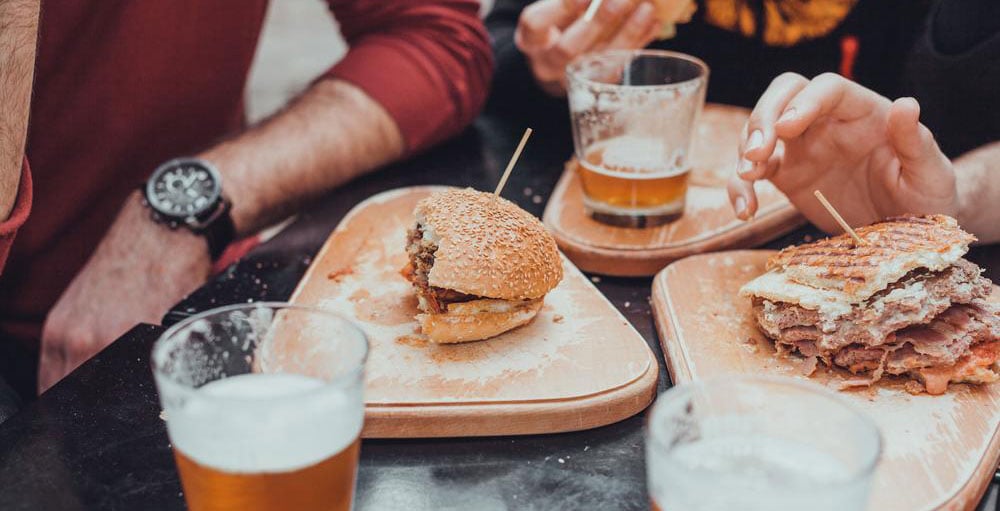Alcohol servers should keep these factors in mind when serving and know the impact on intoxication levels.
How much a person has had to drink is not the only factor that can affect how intoxicated they are. Alcohol servers and bartenders are responsible for counting drinks and estimating their customers’ intoxication levels — but what are the other factors that can affect a person’s Blood Alcohol Concentration (BAC)?
Learn more about the 5 most common factors that also affect a person’s intoxication levels, and tips on how you can ensure you don’t overserve your customers.
1. Food digesting in your body while drinking
How fast alcohol is absorbed into the bloodstream is affected by the food that’s being digested in your stomach or intestines. After consuming a big meal, the rate at which alcohol is absorbed into the bloodstream slows down.
The effects of alcohol are delayed when alcohol absorption is slowed, but the liver continues to metabolize alcohol at the same rate. This means a person’s BAC may not reach as high a level as it would if they were drinking on an empty stomach.
The best foods to eat to slow the absorption of alcohol are meals with high protein or fatty foods, since they are the hardest for the body to digest and stay in the stomach longer.
2. How much and how fast you drink
Any standard drink contains the same amount of alcohol, even if the fluid ounce amounts are different. For example, a standard shot of tequila has the same amount of alcohol as a standard 5-ounce glass of wine. But typically, a person takes a shot in an instant while wine takes a few minutes to drink at the very least.
The faster someone drinks, the quicker the alcohol will enter the bloodstream, making them more intoxicated than someone who consumes their drink at a slower pace. However, it’s important to remember that intoxication can occur in as little as one standard drink.
3. Your alcohol tolerance
Alcohol tolerance varies from person to person. People can slowly build up a higher tolerance for alcohol through prolonged drinking habits, so that they will need to drink more alcohol over time to feel the same effects as they did when they first started drinking.
It’s important to remember that while someone can have a higher tolerance for alcohol, they will still have the same BAC as another person who has consumed the same amount of alcohol. They may be able to mask the signs of intoxication, like slurring their speech, but that doesn’t mean that their judgment, reflexes and motor skills are not impaired. Even though they don’t appear intoxicated, their BAC may still be at .08% or higher, meaning they are not legally permitted to drive.
4. Drinking at high altitudes
Altitude can impact the body’s reaction to alcohol. “Thin air” occurs at high altitudes, where the air is less dense than the air closer to sea level, and exerts less pressure than air at a lower altitude. Mixing thin air with alcohol can make the effects of alcohol twice as potent.
5. Taking medication or other drugs
The effects of alcohol are also stronger when it is mixed with medication or other recreational and illegal drugs. Some medications and drugs can cause impairment, and can result in dangerous consequences when mixed with alcohol. Many fatal overdoses involve a combination of alcohol and medications or illegal drugs.
Even common medications, like allergy or cold medicine, can react negatively with alcohol. Some examples are Aspirin or Tylenol, which can increase the absorption rate of alcohol and heighten its effects.
Tips to keep in mind when serving alcohol
In addition to observing their behavior, keep these tips in mind when serving customers to ensure they are enjoying their drinks safely and responsibly:
- Count drinks and keep track of how fast your customers are drinking them.
- Offer some food if you feel that a customer may be drinking too much, as eating can help slow the alcohol absorption into their bloodstream.
- Remember that even if someone doesn’t appear to be intoxicated, the amount of alcohol they’ve had might bring their BAC to .08% or higher.
- If your business is located at a higher altitude, remember that the effects of alcohol may be more potent.
- Know that your customers may also be taking medication, recreational or illegal drugs and keep this in mind when observing their behavior.
If you think that a customer has had too much to drink or is too intoxicated, it’s your responsibility to stop service. We understand that this particular part of the job can be uncomfortable, and even potentially dangerous, so we’ve put together some proven techniques for stopping service. Always communicate with your managers and colleagues when you’re stopping service in case you need assistance or are changing shifts before the customer has left.
Get the tools you need to responsibly serve alcohol to customers with Userve’s Alcohol Server / Seller Training. Empower yourself and the rest of your team to connect with your customers while keeping everyone’s safety top of mind.

